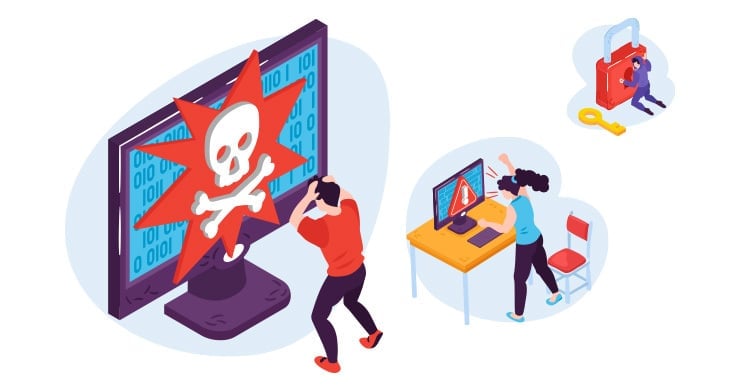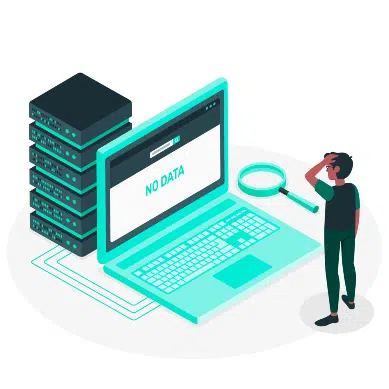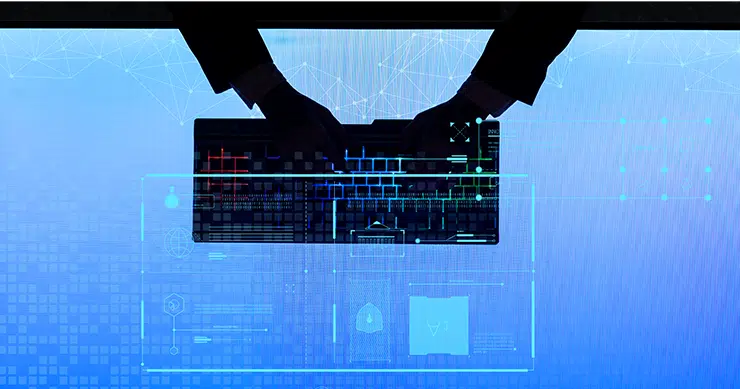The days of cybersecurity being a job exclusively for IT is over. In the past, data security was often handled separately from other forms of business management.
But the risk landscape is growing even more dire by the year. With malware attacks increasing around the world, spending on cybersecurity has reached an all-time high. Management teams have taken notice and recognize the need for more visibility into the everyday cyber threats that impact them.
As new malware gets released every day and new data breaches become commonplace, cybersecurity specialists are on the hunt for more efficient ways to manage their threats. What they needed was an empirical way to measure these cybersecurity risks and prioritize them so that they can focus on addressing the most pressing problems first.
Enter cyber risk quantification (CRQ). Quantifying cyber risk is based on determining the financial impact of a cybersecurity threat. As the cumulative spending for cybersecurity is expected to reach $1.75 trillion by 2025, businesses are interested in quantifying these threats in terms of money lost.

Defining the Terms
But let’s back up a bit first. What does cyber risk entail? And how does CRQ fit into a general business workflow? What are the cyber risk quantification models worth noting?
Defining “Cyber Risk”
“Cybersecurity risk” is actually an umbrella term containing many of the methods cybercriminals use to try to breach into company servers and resources. They include, but are not limited to:
- Viruses and malware: Malicious software is designed to gain unauthorized access to a computer system and disrupt operations. You’ve likely dealt with viruses before on a personal computer.
- Ransomware: This form of malware blocks access to the files on a computer (typically through encryption) and demands a ransom be paid in order to unlock access.
- Phishing attacks: Social engineering is used to convince authorized employees at a company to give away sensitive information like payment data or important passwords.
- Identity theft: The cybercriminal pretends to be an authorized user in a business network and performs operations that would otherwise not be allowed.
- Data breaches: Here’s an attack that’s notorious in the news for targeting small and large companies. Data breaches occur when sensitive or personal information belonging to employees or customers gets leaked out to unauthorized parties.
- DDoS attacks: A distributed denial-of-service attack involves disrupting access to a network in order to make a certain resource unavailable to intended users.
No matter what the risk is, cybersecurity threats like these can disrupt normal operations and cause you to leak personal data of your clients. The result is a compromised reputation in the market and the potential to be charged with non-compliance regarding data security laws.
All cyber threats act on an asset within your company, whether it’s a server or a directory of sensitive data. Analyzing cyber risk is about determining the probability that an asset will be compromised and measuring what the loss would be if it were to be compromised.
What Is Cyber Risk Quantification?
Cyber risk quantification measures the potential consequences of a cyber risk in terms of the amount of money you’re likely to lose to it. It’s an important metric because it helps a company make more informed business decisions about its security posture and helps prioritize which vulnerabilities and threats to address first.
By looking from the perspective of financial impact, CRQ effectively bridges the gap between IT security teams and management groups. It allows the stakeholders to understand the gravity of the situation and know how much they could be losing if they don’t invest in stronger protections.
It’s worth noting that CRQ cannot be applied to all cyber risks. You can’t, for instance, determine the exact losses you take from a future ransomware attack since you won’t know what the ransom amount is. But you can measure CRQ for a malware attack since you know the value of the assets that would be compromised by it.
Cyber risk quantification can be performed using various models, from financial metrics to qualitative and quantitative metrics. But the most important benefit of CRQ is the ability to benchmark and track your progress over time. As you identify and mitigate threats and vulnerabilities, you’ll see how your security posture improves continuously with your efforts.
Start Getting Value With
Centraleyes for Free
See for yourself how the Centraleyes platform exceeds anything an old GRC
system does and eliminates the need for manual processes and spreadsheets
to give you immediate value and run a full risk assessment in less than 30 days
The Factor Analysis of Information Risk Model of CRQ
Factor Analysis of Information Risk (FAIR) is one of the leading cyber risk quantification methods. Developed by the nonprofit FAIR institute, it’s designed to help businesses reduce their operational risk.
By describing cyber risks in terms of the financial losses incurred, FAIR puts everyone on the same page when it comes to addressing vulnerabilities, not just the IT and security departments. While other cyber risk frameworks like NIST and ISO can be effective, they don’t emphasize financial impact as much. In fact, it’s not uncommon to see FAIR integrate with NIST and ISO frameworks.
Once you know the financial impact of certain risks, you can decide on future investments in IT security technology.
The DREAD Framework
The DREAD framework for CRQ goes even deeper beyond the financial impact of a cyber risk. As the acronym implies, it covers all of the following aspects of a cyber risk.
- Damage potential, the amount of problems it will cause the business
- Reproducibility, how easy it is to recreate the attack
- Exploitability, how easy it is to take advantage of the vulnerability
- Affected entities, the “impact zone” of the attack
- Discoverability, how easy it is for you to discover the threat and address it
DREAD uses a numerical scale to grade the criticality of each cyber risk, thereby helping to prioritize risks accordingly.
Best Practices for Cyber Security Risk Quantification
Your cyber risk quantification journey is your own. Every business has its own threat landscape and specific requirements when it comes to digital security. However, some base-level best practices to follow are below.
- Communicate with your teams to define your cybersecurity efforts in the context of CRQ. Make sure everyone is on the same page when it comes to knowing what the cyber threats are. You can align your objectives and efforts this way and reduce confusion.
- Prioritize your risks by assigning criticality ratings for all your assets and determining the probabilities that each will be impacted by a malware attack. Ensure that security teams work on high-priority threats first so that they don’t tire out trying to cover everything.
- Document all your efforts. Documentation records all your progress over time and helps you make future business decisions regarding your CRQ efforts.
- Collect data effectively by pulling information about the sources of potential threats. It’s common to use security management tools and APIs to gather this accurate data to help in security audits and analyses.
Finally, you can use software tools to help you not only gather information about potential cyber risks but also understand the context behind each of them.
Applying Cyber Risk Quantification to Your Organization with CentralEyes
CRQ methodologies are useful for measuring your own cybersecurity posture, but did you know that the security of your third-party business partners and clients can also be quantified? You have to share sensitive data and services with these entities, so any cyber risks that apply to them apply to you.
That’s why cyber risk quantification tools are often used to help analyze risks of both a company and its connections. In today’s threat-laden landscape, it’s almost impossible to address all these cyber risks properly through manual means.
Centraleyes is a cyber risk management platform designed specifically to cover risk quantification at scale. Watch our demo and see how automated compliance tools help you grasp all types of risk management, from cybersecurity to governance and compliance frameworks.
Start Getting Value With
Centraleyes for Free
See for yourself how the Centraleyes platform exceeds anything an old GRC
system does and eliminates the need for manual processes and spreadsheets
to give you immediate value and run a full risk assessment in less than 30 days





